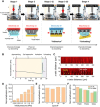Electrothermal soft manipulator enabling safe transport and handling of thin cell/tissue sheets and bioelectronic devices
- PMID: 33067233
- PMCID: PMC7567602
- DOI: 10.1126/sciadv.abc5630
Electrothermal soft manipulator enabling safe transport and handling of thin cell/tissue sheets and bioelectronic devices
Abstract
"Living" cell sheets or bioelectronic chips have great potentials to improve the quality of diagnostics and therapies. However, handling these thin and delicate materials remains a grand challenge because the external force applied for gripping and releasing can easily deform or damage the materials. This study presents a soft manipulator that can manipulate and transport cell/tissue sheets and ultrathin wearable biosensing devices seamlessly by recapitulating how a cephalopod's suction cup works. The soft manipulator consists of an ultrafast thermo-responsive, microchanneled hydrogel layer with tissue-like softness and an electric heater layer. The electric current to the manipulator drives microchannels of the gel to shrink/expand and results in a pressure change through the microchannels. The manipulator can lift/detach an object within 10 s and can be used repeatedly over 50 times. This soft manipulator would be highly useful for safe and reliable assembly and implantation of therapeutic cell/tissue sheets and biosensing devices.
Copyright © 2020 The Authors, some rights reserved; exclusive licensee American Association for the Advancement of Science. No claim to original U.S. Government Works. Distributed under a Creative Commons Attribution NonCommercial License 4.0 (CC BY-NC).
Figures






References
-
- Yang J., Yamato M., Kohno C., Nishimoto A., Sekine H., Fukai F., Okano T., Cell sheet engineering: Recreating tissues without biodegradable scaffolds. Biomaterials 26, 6415–6422 (2005). - PubMed
-
- Yang J., Yamato M., Shimizu T., Sekine H., Ohashi K., Kanzaki M., Ohki T., Nishida K., Okano T., Reconstruction of functional tissues with cell sheet engineering. Biomaterials 28, 5033–5043 (2007). - PubMed
-
- Nishida K., Yamato M., Hayashida Y., Watanabe K., Maeda N., Watanabe H., Yamamoto K., Nagai S., Kikuchi A., Tano Y., Okano T., Functional bioengineered corneal epithellial sheet grafts from corneal stem cells expanded ex vivo on a temperature-responsive cell culture surface. Transplantation 77, 379–385 (2004). - PubMed
-
- Kim D.-H., Lu N., Ma R., Kim Y.-S., Kim R.-H., Wang S., Wu J., Won S. M., Tao H., Islam A., Yu K. J., Kim T.-i., Chowdhury R., Ying M., Xu L., Li M., Chung H.-J., Keum H., Cormick M. M., Liu P., Zhang Y.-W., Omenetto F. G., Huang Y., Coleman T., Rogers J. A., Epidermal electronics. Science 333, 838–843 (2011). - PubMed
Publication types
Grants and funding
LinkOut - more resources
Full Text Sources
Other Literature Sources

